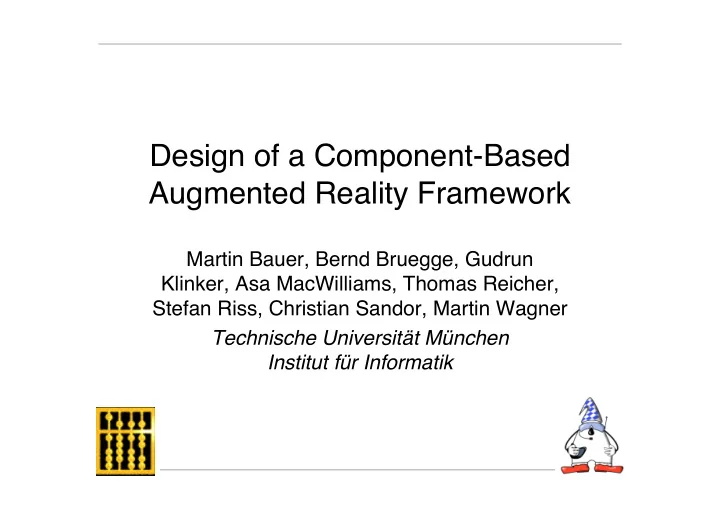

Design of a Component-Based Augmented Reality Framework Design of a Component-Based Augmented Reality Framework Martin Bauer, Bernd Bruegge, Gudrun Klinker, Asa MacWilliams, Thomas Reicher, Stefan Riss, Christian Sandor, Martin Wagner Technische Universität München Institut für Informatik ISAR 2001, Oct. 29 Asa MacWilliams Slide 1 of 16
Design of a Component-Based Augmented Reality Framework Summary • We think the time has come for augmented reality frameworks • This will allow software components to be reused between different AR applications • We have built and tested a first version of such a framework, called DWARF ISAR 2001, Oct. 29 Asa MacWilliams Slide 2 of 16
Design of a Component-Based Augmented Reality Framework Outline • Advantages of an AR framework • Necessary elements of an AR framework • DWARF – architecture and components • Demonstration system ISAR 2001, Oct. 29 Asa MacWilliams Slide 3 of 16
Design of a Component-Based Augmented Reality Framework Advantages– Project manager • Components can be reused in different applications • Components are “black boxes” for other components • Distribute development in time and space • Rapid prototyping of AR applications becomes feasible ISAR 2001, Oct. 29 Asa MacWilliams Slide 4 of 16
Design of a Component-Based Augmented Reality Framework Advantages– User • Software is integrated with hardware in wearable or stationary modules • System is reconfigured by re-plugging modules ISAR 2001, Oct. 29 Asa MacWilliams Slide 5 of 16
Design of a Component-Based Augmented Reality Framework Advantages– Application developer • System consists of layered services • Application is modeled by configuring services ISAR 2001, Oct. 29 Asa MacWilliams Slide 6 of 16
Design of a Component-Based Augmented Reality Framework Advantages– Module developer • Modules are hardware with software services • Services provide basic functionality, e.g. tracking • Services have needs and abilities ISAR 2001, Oct. 29 Asa MacWilliams Slide 7 of 16
Design of a Component-Based Augmented Reality Framework Elements of an AR framework • Services providing general functionality – General enough to reuse, yet also efficient • Architecture to fit the services together – Generalization of many different AR systems • Middleware to let services communicate – Must allow fast yet flexible communication ISAR 2001, Oct. 29 Asa MacWilliams Slide 8 of 16
Design of a Component-Based Augmented Reality Framework DWARF– Main services • Distributed Wearable Augmented Reality Framework as test of framework concepts • First DWARF services cover the basic functionalities for AR applications – World model, optical tracker, GPS/compass tracker, tracking manager, user interface engine,VRML viewer, HTML viewer, voice recognition, taskflow engine, context router • Implementation of services uses well- established and third-party technology ISAR 2001, Oct. 29 Asa MacWilliams Slide 9 of 16
Design of a Component-Based Augmented Reality Framework DWARF– Generic architecture ISAR 2001, Oct. 29 Asa MacWilliams Slide 10 of 16
Design of a Component-Based Augmented Reality Framework DWARF– Middleware • To find each other spontaneously and communicate with one another, the DWARF services use CORBA- based Middleware • This is distributed as local Service Managers on each hardware node to provide fault tolerance ISAR 2001, Oct. 29 Asa MacWilliams Slide 11 of 16
Design of a Component-Based Augmented Reality Framework Demo system– Navigation scenario • Indoor and outdoor campus navigation system • Wireless access to external services • 2D maps, 3D maps and AR overlays ISAR 2001, Oct. 29 Asa MacWilliams Slide 12 of 16
Design of a Component-Based Augmented Reality Framework Demo system– Using the framework • Nearly entire functionality is handled by the DWARF services – Navigation sequence, campus geography, multi- modal I/O, printer location, outdoor tracking, indoor tracking, 3D rendering • Application design is greatly simplified – Model campus and navigation in markup languages – Bootstrapping, glue logic • Application implemented in three weeks’ time ISAR 2001, Oct. 29 Asa MacWilliams Slide 13 of 16
Design of a Component-Based Augmented Reality Framework Demo system– Hardware • Backpack system for demonstration of software • Two laptops running Windows NT and 98 • Glasstron see-though HMD, FireWire Camera for Optical Tracking, commercial GPS receiver, Bluetooth / WaveLAN wireless communication • Battery-powered, > 2 hours of operation ISAR 2001, Oct. 29 Asa MacWilliams Slide 14 of 16
Design of a Component-Based Augmented Reality Framework Conclusion • The time has come for AR frameworks – Technology is becoming mature – Number of AR research groups is increasing • We have investigated the feasibility of AR frameworks – Componentization is workable – Performance does not suffer from distribution – Rapid application development becomes possible • We would like to encourage a discussion on framework components and technology. ISAR 2001, Oct. 29 Asa MacWilliams Slide 15 of 16
Design of a Component-Based Augmented Reality Framework Thank you • Any questions? ISAR 2001, Oct. 29 Asa MacWilliams Slide 16 of 16
Recommend
More recommend